Estuarine Turbidity Maxima and Variations of Aggregate Parameters in the Cam-Nam Trieu Estuary, North Vietnam, in Early Wet Season
Abstract
:1. Introduction
2. The Cam-Nam Trieu Estuary
3. Material and Methods
3.1. Field Data
3.2. Data Processing
3.2.1. SPM Concentration and the Ratio Organic to Inorganic Matter in the Solids of Flocs
3.2.2. SPM Volume Concentration (SPMVC) and Particle Size Distribution (PSD)
3.2.3. Excess of Density and Settling Velocity of Flocs
3.2.4. Richardson Number
3.2.5. Simpson Parameter
4. Results
4.1. River Discharge, SPM and Turbidity
4.2. Excess of Density of Flocs
4.2.1. Tidal Variations of ∆ρf from Measurements
4.2.2. Comparison between Measured and Modelled Values of ∆ρf and ws
4.3. ETM Characteristics at Different Tidal Stages
4.3.1. Transect 1–Flood Tide
4.3.2. Transect 2–Low Tide
4.3.3. Transect 3–Flood Tide
4.3.4. Transect 4–Low Tide
4.3.5. Transect 5–High Tide
4.3.6. Transect 6–Ebb Tide
5. Discussion and Conclusions
5.1. Q, Qs and SPM in Early Flood Season
5.2. General Patterns of ETMs
5.3. D50 and Excess of Density of Flocs
5.4. Fractal Dimension
5.5. Settling Velocity of Flocs
5.6. On the Origins of ETMs in the Cam-Nam Trieu Estuary
Supplementary Materials
Acknowledgments
Author Contributions
Conflicts of Interest
References
- Fettweis, M.; Sas, M.; Monbaliu, J. Seasonal, Neap-spring and tidal variation of cohesive sediment concentration in the Scheldt estuary, Belgium. Estuar. Coast. Shelf Sci. 1998, 47, 21–36. [Google Scholar] [CrossRef]
- Mitchell, S.B.; Uncles, R.J. Estuarine sediments in macrotidal estuaries: Future research requirements and management challenges. Ocean Coast. Manag. 2013, 79, 97–100. [Google Scholar] [CrossRef]
- Kistner, D.A.; Pettigrew, N.R. A variable turbidity maximum in the Kennebec Estuary. Estuaries 2001, 24, 680–687. [Google Scholar] [CrossRef]
- Uncles, R.J.; Stephens, J.A.; Smith, R.E. The dependence of estuarine turbidity on tidal intrusion length, tidal range and residence time. Cont. Shelf Res. 2002, 22, 1835–1856. [Google Scholar] [CrossRef]
- Kirby, R.; Parker, W.R. Distribution and behavior of fine sediment in the Severn Estuary and Inner Bristol Channel, UK. Can. J. Fish. Aquat. Sci. 1983, 40, 83–95. [Google Scholar] [CrossRef]
- Allen, G.P.; Castaing, P. Suspended sediment transport from the Gironde estuary (France) onto the adjacent continental shelf. Mar. Geol. 1973, 14, 47–53. [Google Scholar] [CrossRef]
- Sottolichio, A.; Castaing, P. A synthesis on seasonal dynamics of highly concentrated structures in the Gironde estuary. Comptes Rendus l’Acad. Sci. Paris IIa 1999, 329, 895–900. [Google Scholar] [CrossRef]
- Jalón-Rojas, I.; Schmidt, S.; Sottolichio, A. Turbidity in the fluvial Gironde Estuary (southwest France) based on 10-year continuous monitoring: Sensitivity to hydrological conditions. Hydrol. Earth Syst. Sci. 2015, 19, 2805–2819. [Google Scholar] [CrossRef]
- Olsen, C.R.; Simpson, H.J.; Bopp, R.F.; Williams, S.C.; Peng, T.H.; Deck, B.L. A geochemical analysis of the sediments and sedimentation in the Hudson estuary. J. Sediment. Petrol. 1978, 48, 401–418. [Google Scholar]
- Geyer, W.R.; Woodruff, J.D.; Traykovski, P. Sediment transport and trapping in the Hudson River Estuary. Estuaries 2001, 24, 670–679. [Google Scholar] [CrossRef]
- Traykovski, P.; Geyer, W.R.; Sommerfield, C. Rapid sediment deposition and fine-scale strata formation in the Hudson estuary. J. Geophys. Res. 2004, 109, F02004. [Google Scholar] [CrossRef]
- Jay, D.A.; Musiak, J.D. Particle trapping in estuarine tidal flows. J. Geophys. Res. 1994, 99, 20445–20461. [Google Scholar] [CrossRef]
- Brenon, I.; Le Hir, P. Modelling the turbidity maximum in the Seine estuary (France): Identification of formation processes. Estuar. Coast. Shelf Sci. 1999, 49, 525–544. [Google Scholar] [CrossRef]
- Sanford, L.P.; Suttles, S.E.; Halka, J.P. Reconsidering the physics of the Chesapeake Bay estuarine turbidity maximum. Estuaries 2001, 24, 655–669. [Google Scholar] [CrossRef]
- Sanford, L.P.; Dickhudt, P.J.; Rubiano-Gomez, L.; Yates, M.; Suttles, S.E.; Friedrichs, C.T.; Fugate, D.D.; Romine, H. Variability of suspended particle concentrations, sizes, and settling velocities in the Chesapeake Bay turbidity maximum. In Flocculation in Natural and Engineered Environmental Systems; Droppo, I.G., Leppard, G.G., Liss, S.N., Milligan, T.G., Eds.; CRC Press: Boca Raton, FL, USA, 2005; pp. 211–236. [Google Scholar]
- Uncles, R.J.; Stephens, J.A.; Harris, C. Runoff and tidal influences on the estuarine turbidity maximum of a highly turbid system: The upper Humber and Ouse Estuary, UK. Mar. Geol. 2006, 235, 213–228. [Google Scholar] [CrossRef]
- Postma, H. Sediment transport and sedimentation in the estuarine environment. In Estuaries; Lauff, G.H., Ed.; American Association Advanced Scientific Publication: Washington, DC, USA, 1967; pp. 158–179. [Google Scholar]
- Bowden, K.F. Turbulence and mixing in estuaries. In The Estuary as a Filter; Kennedy, V.S., Ed.; Academic Press: Orlando, FL, USA, 1984; pp. 15–26. [Google Scholar]
- Toublanc, F.; Brenon, I.; Coulombier, T. Formation and structure of the turbidity maximum in the macrotidal Charente estuary (France): Influence of fluvial and tidal forcing. Estuar. Coast. Shelf Sci. 2016, 169, 1–14. [Google Scholar] [CrossRef]
- Schubel, J.R. Turbidity maximum of the northern Chesapeake Bay. Science 1968, 161, 1013–1015. [Google Scholar] [CrossRef] [PubMed]
- Allen, G.P.; Salomon, J.C.; Bassoullet, P.; du Penhoat, Y.; de Grandpré, C. Effects of tides on mixing and suspended sediment transport in macrotidal estuaries. Sediment. Geol. 1980, 26, 69–90. [Google Scholar] [CrossRef]
- Sottolichio, A.; Le Hir, P.; Castaing, P. Modeling mechanisms for the stability of the turbidity maximum in the Gironde estuary, France. Proc. Mar. Sci. 2000, 3, 373–386. [Google Scholar]
- Coleman, J.M.; Wright, L.D. Sedimentation in an arid macrotidal alluvial river system: Ord River, Western Australia. J. Geol. 1978, 86, 621–642. [Google Scholar] [CrossRef]
- Uncles, R.J.; Stephens, J.A. Nature of the turbidity maximum in the Tamar Estuary, UK. Estuar. Coast. Shelf Sci. 1993, 36, 413–431. [Google Scholar] [CrossRef]
- Komar, P.D.; Taghon, G.L. Analyses of the settling velocities of fecal pellets from the subtidal polychaete Amphicteis scaphobranchiata. J. Mar. Res. 1985, 43, 605–614. [Google Scholar] [CrossRef]
- Geyer, W.R. The importance of suppression of turbulence by stratification on the estuarine turbidity maximum. Estuaries 1993, 16, 113–125. [Google Scholar] [CrossRef]
- Geyer, W.R.; Signell, R.; Kineke, G. Lateral trapping of sediment in a partially mixed estuaries. In Physics of Estuaries and Coastal Seas: Proceedings of the 8th International Biennial Conference on Physics of Estuaries and Coastal Seas, Hague, The Netherlands, 9–12 September 1996; Dronkers, J., Scheffers, M., Eds.; A.A. Balkema: Rotterdam, The Netherlands, 1998; pp. 115–124. [Google Scholar]
- Hill, P.S.; McCave, L.N. Suspended Particle Transport in Benthic Boundary Layers. In The Bemic Boundary Layer; Boudreau, B.P., Bo Barker, J., Eds.; Oxford University Press: New York, NY, USA, 2001; pp. 78–103. [Google Scholar]
- Hill, P.S.; Voulgaris, G.; Trowbridge, J.H. Controls on floc size in a continental shelf bottom boundary layer. J. Geophys. Res. Oceans 2001, 106, 9543–9549. [Google Scholar] [CrossRef]
- Haiphong statistics office. Haiphong Statistics Yearbook 2016; Statistical Publishing house: Hai Phong, Vietnam, 2017.
- Vietnam maritime administration (Vinamarine). Approved planning for dredging in Hai Phong port. Available online: http://www.vinamarine.gov.vn (accessed on 29 July 2017).
- Vuong, B.V.; Liu, Z.F.; Thanh, T.D.; Khang, N.D. Initial results of study in sedimentation rate and geochronology of modern sediments in the Bach Dang estuary by the methods of 210Pb and 137Cs radio tracer. In Proceedings of the Second National Scientific Conference on Marine Geology, Ha Noi-Ha Long, Vietnam, 10–11 October 2013; pp. 306–315. [Google Scholar]
- Thanh, T.D.; Can, N.; Nga, D.D.; Huy, D.V. Coastal development and sea level change during Holocene in Haiphong area. J. Mar. Sci. Technol. 2004, 3, 25–42. [Google Scholar]
- Cu, N.V.; Huong, N.T.T.; Cham, D.D. Causes and Proposal Solution for Deposition in Navigation Channel to Hai Phong Ports. Final Report of the MOST Project; The Institute of Geology: Hanoi City, Vietnam, 1997. (In Vietnamese) [Google Scholar]
- Cu, N.V.; Cham, D.D. Research on Hydrodynamics, Sediment Transport, Deposition in Lach Huyen, South Do Son (Hai Phong) by Influenced of the Deep-Port and Propose Solution. Final Report of the KC.08.10/06-10 Project; The Institute of Geology: Hanoi City, Vietnam, 2010. (In Vietnamese) [Google Scholar]
- Vinh, V.D.; Thanh, T.D. Application of numerical model to study on maximum turbidity zones in Bach Dang estuary. J. Mar. Sci. Technol. 2012, 3, 1–12. [Google Scholar]
- Vinh, V.D.; Uu, D.V. The influence of wind and oceanographic factors on characteristics of suspended sediment transport in Bach Dang estuary. J. Mar. Sci. Technol. 2013, 3, 216–226. [Google Scholar] [CrossRef]
- Lefebvre, J.P.; Ouillon, S.; Vinh, V.D.; Arfi, R.; Panche, J.Y.; Mari, X.; Van Thuoc, C.; Torréton, J.P. Seasonal variability of cohesive sediment aggregation in the Bach Dang-Cam Estuary, Haiphong (Vietnam). Geo-Mar. Lett. 2012, 32, 103–121. [Google Scholar] [CrossRef]
- Mari, X.; Torréton, J.P.; Chu, V.T.; Lefebvre, J.P.; Ouillon, S. Seasonal aggregation dynamics along a salinity gradient in the Bach Dang estuary, North Vietnam. Estuar. Coast. Shelf Sci. 2012, 96, 151–158. [Google Scholar] [CrossRef]
- Vinh, V.D.; Ouillon, S.; Thanh, T.D.; Chu, L.V. Impact of the Hoa Binh dam (Vietnam) on water and sediment budgets in the Red River basin and delta. Hydrol. Earth Syst. Sci. 2014, 18, 3987–4005. [Google Scholar] [CrossRef]
- Minh, N.N.; Marchesiello, P.; Lyard, F.; Ouillon, S.; Cambon, G.; Allain, D.; Van Uu, D. Tidal characteristics of the Gulf of Tonkin. Cont. Shelf Res. 2014, 91, 37–56. [Google Scholar] [CrossRef]
- Traykovski, P.; Latter, R.; Irish, J.D. A laboratory evaluation of the LISST instrument using natural sediments. Mar. Geol. 1999, 159, 355–367. [Google Scholar] [CrossRef]
- Agrawal, Y.C.; Pottsmith, H.C. Instruments for particle size and settling velocity observations in sediment transport. Mar. Geol. 2000, 168, 89–114. [Google Scholar] [CrossRef]
- Mikkelsen, O.A.; Pejrup, M. In situ particle size spectra and density of particle aggregates in a dredging plume. Mar. Geol. 2000, 170, 443–459. [Google Scholar] [CrossRef]
- Voulgaris, G.; Meyers, S.T. Temporal variability of hydrodynamics, sediment concentration and sediment settling velocity in a tidal creek. Cont. Shelf Res. 2004, 24, 1659–1683. [Google Scholar] [CrossRef]
- Mikkelsen, O.A.; Hill, P.S.; Milligan, T.G.; Chant, R.J. In situ particle size distributions and volume concentrations from a LISST-100 laser particle sizer and a digital floc camera. Cont. Shelf Res. 2005, 25, 1959–1978. [Google Scholar] [CrossRef]
- Jouon, A.; Ouillon, S.; Douillet, P.; Lefebvre, J.-P.; Fernandez, J.-M.; Mari, X.; Froidefond, J.-M. Spatio-temporal variability in suspended particulate matter concentration and the role of aggregation on size distribution in a coral reef lagoon. Mar. Geol. 2008, 256, 36–48. [Google Scholar] [CrossRef]
- Andrews, S.; Nover, D.; Schladow, S. Using laser diffraction data to obtain accurate particle size distributions: The role of particle composition. Limnol. Oceanogr. Methods 2010, 8, 507–526. [Google Scholar] [CrossRef]
- Graham, G.W.; Davies, E.J.; Nimmo-Smith, W.A.M.; Bowers, D.G.; Braithwaite, K.M. Interpreting LISST-100X measurements of particles with complex shape using digital in-line holography. J. Geophys. Res. 2012, 117, C05034. [Google Scholar] [CrossRef]
- Fettweis, M.; Baeye, M. Seasonal variation in concentration, size and settling velocity of muddy marine flocs in the benthic boundary layer. J. Geophys. Res. Oceans 2015, 120, 5648–5667. [Google Scholar] [CrossRef]
- Many, G.; Bourrin, F.; Durrieu de Madron, X.; Pairaud, I.; Gangloff, A.; Doxaran, D.; Ody, A.; Verney, R.; Menniti, C.; Le Berre, D.; et al. Particle assemblage characterization in the Rhone river ROFI. J. Mar. Syst. 2016, 157, 39–51. [Google Scholar] [CrossRef]
- Pinet, S.; Martinez, J.M.; Ouillon, S.; Lartiges, B.; Villar, R.E. Variability of apparent and inherent optical properties of sediment-laden waters in large river basins—Lessons from in situ measurements and bio-optical modeling. Opt. Express 2017, 25, A283–A310. [Google Scholar] [CrossRef] [PubMed]
- Bader, H. The hyperbolic distribution of particle sizes. J. Geophys. Res. 1970, 75, 2822–2830. [Google Scholar] [CrossRef]
- Jackson, G.; Maffione, D.; Costello, A.; Alldredge, B.; Logan, B.; Dam, H. Particle size spectra between 1 μm and 1 cm at Monterey Bay determined using multiple instruments. Deep Sea Res. Part I Oceanogr. Res. Pap. 1997, 44, 1739–1767. [Google Scholar] [CrossRef]
- Boss, E.; Twardowski, M.S.; Herring, S. Shape of the particulate beam attenuation spectrum and its inversion to obtain the shape of the particulate size distribution. Appl. Opt. 2001, 40, 4885–4893. [Google Scholar] [CrossRef] [PubMed]
- Wozniak, S.B.; Stramski, D. Modeling the optical properties of mineral particles suspended in seawater and their influence on ocean reflectance and chlorophyll estimation from remote sensing algorithms. Appl. Opt. 2004, 43, 3489–3503. [Google Scholar] [CrossRef] [PubMed]
- Loisel, H.; Nicolas, J.M.; Sciandra, A.; Stramski, D.; Poteau, A. Spectral dependency of optical backscattering by marine particles from satellite remote sensing of the global ocean. J. Geophys. Res. 2006, 111, C09024. [Google Scholar] [CrossRef]
- Jonasz, M. Particle size distribution in the Baltic. Tellus 1983, 35B, 346–358. [Google Scholar] [CrossRef]
- Lee, B.J.; Fettweis, M.; Toorman, E.; Molz, F. Multimodality of a particle size distribution of cohesive suspended particulate matters in a coastal zone. J. Geophys. Res. 2012, 117, C03014. [Google Scholar] [CrossRef]
- Winterwerp, J.C. A simple model for turbulence induced flocculation of cohesive sediment. J. Hydraul. Res. 1998, 36, 309–326. [Google Scholar] [CrossRef]
- Winterwerp, J.C. Stratification effects by cohesive and noncohesive sediment. J. Geophys. Res. 2001, 106, 22559–22574. [Google Scholar] [CrossRef]
- Winterwerp, J.C. A heuristic formula for turbulence-induced flocculation of cohesive sediment. Estuar. Coast. Shelf Sci. 2006, 68, 195–207. [Google Scholar] [CrossRef]
- Stokes, G.G. On the Effect of the Internal Friction of Fluids on the Motion of Pendulums. In Transaction Cambridge Philosophical Society; Printed at the Pitt Press: Cambridge, UK, 1851; Volume IX, pp. 8–106, Reprinted In Mathematical and Physical Papers, 2nd ed.; Johnson Reprint Corp: New York, NY, USA, 1966; Volume 3. [Google Scholar]
- Kranenburg, C. The fractal structure of cohesive sediment aggregates. Estuar. Coast. Shelf Sci. 1994, 39, 451–460. [Google Scholar] [CrossRef]
- Maggi, F. Biological flocculation of suspended particles in nutrient-rich aqueous ecosystems. J. Hydrol. 2009, 376, 116–125. [Google Scholar] [CrossRef]
- Maerz, J.; Hofmeister, R.; van der Lee, E.M.; Gräwe, U.; Riethmüller, R.; Wirtz, K.W. Maximum sinking velocities of suspended particulate matter in a coastal transition zone. Biogeosciences 2016, 13, 4863–4876. [Google Scholar] [CrossRef]
- Van der Lee, E.M.; Bowers, D.; Kyte, E. Remote sensing of temporal and spatial patterns of suspended particle size in the Irish Sea in relation to the Kolmogorov microscale. Cont. Shelf Res. 2009, 29, 1213–1225. [Google Scholar] [CrossRef]
- Fettweis, M. Uncertainty of excess density and settling velocity of mud flocs derived from in situ measurements. Estuar. Coast. Shelf Sci. 2008, 78, 426–436. [Google Scholar] [CrossRef]
- Ouillon, S.; Douillet, P.; Petrenko, A.; Neveux, J.; Dupouy, C.; Froidefond, J.M.; Andréfouët, S.; Muñoz-Caravaca, A. Optical algorithms at satellite wavelengths for Total Suspended Matter in tropical coastal waters. Sensors 2008, 8, 4165–4185. [Google Scholar] [CrossRef] [PubMed]
- Miles, J. Richardson’s criterion for the stability of stratified shear flow. Phys. Fluids 1986, 29, 3470. [Google Scholar] [CrossRef]
- Simpson, J.H.; Allen, C.M.; Morris, N.C.G. Fronts on the continental shelf. J. Geophys. Res. 1978, 83, 4607–4614. [Google Scholar] [CrossRef]
- Roberts, W.P.; Pierce, J.W. Deposition in upper Patuxent estuary, Maryland, 1968–1969. Estuar. Coast. Mar. Sci. 1976, 4, 267–280. [Google Scholar] [CrossRef]
- Buller, A.T. Sediments of the Tay Estuary. II. Formation of Ephemeral Zones of High Suspended Sediment Concentrations. Proc. R. Soc. Edinb. Sect. B Nat. Environ. 1975, 75, 65–89. [Google Scholar] [CrossRef]
- Dobereiner, C.; McManus, J. Turbidity Maximum Migration and Harbor Siltation in the Tay Estuary. Can. J. Fish. Aquat. Sci. 1983, 40, s117–s141. [Google Scholar] [CrossRef]
- Doxaran, D.; Froidefond, J.M.; Castaing, P.; Babin, M. Dynamics of the turbidity maximum zone in a macrotidal estuary (the Gironde, France): Observations from field and MODIS satellite data. Estuar. Coast. Shelf Sci. 2009, 81, 321–332. [Google Scholar] [CrossRef]
- Grabemann, I.; Uncles, R.J.; Krause, G.; Stephens, J.A. Behaviour of Turbidity Maxima in the Tamar (U.K.) and Weser (F.R.G.) Estuaries. Estuar. Coast. Shelf Sci. 1997, 45, 235–246. [Google Scholar] [CrossRef]
- Le Bris, H.; Glémarec, M. Marine and brackish ecosystems of south Brittany (Lorient and Vilaine Bays) with particular reference to the effect of the turbidity maxima. Estuar. Coast. Shelf Sci. 1996, 42, 737–753. [Google Scholar] [CrossRef]
- Simpson, J.H.; Brown, J.; Matthews, J.; Allen, G. Tidal straining, density currents, and stirring in the control of estuarine stratification. Estuaries 1990, 13, 125–132. [Google Scholar] [CrossRef]
- Schoellhamer, D.H. Influence of salinity, bottom topography, and tides on locations of estuarine turbidity maxima in northern San Francisco Bay. In Proceedings in Marine Science; McAnally, W.H., Mehta, A.J., Eds.; Elsevier Science: Amsterdam, The Netherlands, 2000; Volume 3, pp. 343–357. [Google Scholar]
- Lin, J.; Kuo, A.Y. Secondary turbidity maximum in a micro-tidal partially mixed estuary. Estuaries 2001, 24, 707–720. [Google Scholar] [CrossRef]
- Lin, J.; Kuo, A.Y. A model study of turbidity maxima in the York River Estuary, Virginia. Estuaries 2003, 26, 1269–1280. [Google Scholar] [CrossRef]
- Hamblin, P.F. Observations and model of sediment transport near the turbidity maximum of the upper Saint Lawrence Estuary. J. Geophys. Res. 1989, 94, 14419–14428. [Google Scholar] [CrossRef]
- Wolanski, E.; Huan, N.N.; Dao, L.T.; Nhan, N.H.; Thuy, N.N. Fine-sediment Dynamics in the Mekong River Estuary, Vietnam. Estuar. Coast. Shelf Sci. 1996, 43, 565–582. [Google Scholar] [CrossRef]
- Guo, C.; He, Q.; Guo, L.; Winterwerp, J.C. A study of in-situ sediment flocculation in the turbidity maxima of the Yangtze Estuary. Estuar. Coast. Shelf Sci. 2017, 191, 1–9. [Google Scholar] [CrossRef]
- Manning, A.J.; Langston, W.J.; Jonas, P.J.C. A review of sediment dynamics in the Severn estuary: Influence of flocculation. Mar. Poll. Bull. 2010, 61, 37–51. [Google Scholar] [CrossRef] [PubMed]
- Khelifa, A.; Hill, P.S. Models for effective density and settling velocity of flocs. J. Hydraul. Res. 2006, 44, 390–401. [Google Scholar] [CrossRef]
- Tambo, N.; Watanabe, Y. Physical characteristics of flocs. I. The floc density function and aluminium floc. Water Res. 1979, 13, 409–419. [Google Scholar] [CrossRef]
- Dyer, K.R.; Manning, A.J. Observation of the size, settling velocity, and effective density of flocs, and their fractal dimension. J. Sea Res. 1999, 41, 87–95. [Google Scholar] [CrossRef]
- Verney, R.; Lafite, R.; Brun Cottan, J.C. Flocculation potential of natural estuarine particles: The importance of environmental factors and of the spatial and seasonal variability of suspended particulate matter. Estuar. Coast. 2009, 32, 678–693. [Google Scholar] [CrossRef]
- Bowers, D.G.; McKee, D.; Jago, C.F.; Nimmo-Smith, W.A.M. The area-to-mass ratio and fractal dimension of marine flocs. Estuar. Coast. Shelf Sci. 2017, 189, 224–234. [Google Scholar] [CrossRef]
- Winterwerp, J.C. On the Dynamics of High Concentrated Mud Suspensions. Ph.D. Thesis, Delft University of Technology, Delft, The Netherlands, October 1999; 171p. [Google Scholar]
- Kranck, K. The role of flocculation in the filtering of particulate matter in estuaries. In The Estuary as a Filter; Kennedy, V., Ed.; Academic Press: Orlando, FL, USA, 1984; pp. 159–175. [Google Scholar]
- Mehta, A.J. On estuarine cohesive sediment suspension behaviour. J. Geophys. Res. 1989, 94, 14303–14314. [Google Scholar] [CrossRef]
- Johnson, C.P.; Li, X.; Logan, B.E. Settling velocities of fractal aggregates. Environ. Sci. Technol. 1996, 30, 1911–1918. [Google Scholar] [CrossRef]
- Xia, X.M.; Li, Y.; Yang, H.; Wu, C.Y.; Sing, T.H.; Pong, H.K. Observations on the size and settling velocity distributions of suspended sediment in the Pearl River Estuary, China. Cont. Shelf Res. 2004, 24, 1809–1826. [Google Scholar] [CrossRef]
- Dyer, K.R. Coastal and Estuarine Sediment Dynamics; John Wiley & Sons: Chichester, UK, 1986; 342p. [Google Scholar]
- Hugues, M.G.; Harris, P.T.; Hubble, C.T. Dynamics of the turbidity maximum zone in a micro-tidal estuary: Hawkesbury River, Australia. Sedimentology 1998, 45, 397–410. [Google Scholar] [CrossRef]
- Eisma, D. Suspended Matter in the Aquatic Environment; Springer: Berlin, Germany, 1993. [Google Scholar]
- Jalon-Rojas, I.; Schmidt, S.; Sottolichio, A.; Bertier, C. Tracking the turbidity maximum zone in the Loire estuary (France) based on a long-term, high-resolution and high-frequency monitoring network. Cont. Shelf Res. 2016, 117, 1–11. [Google Scholar] [CrossRef]
- Uncles, R.J.; Barton, M.L.; Stephens, J.A. Seasonal Variability of fine-sediment concentrations in the Turbidity Maximum region of the Tamar estuary. Estuar. Coast. Shelf Sci. 1994, 38, 19–39. [Google Scholar] [CrossRef]
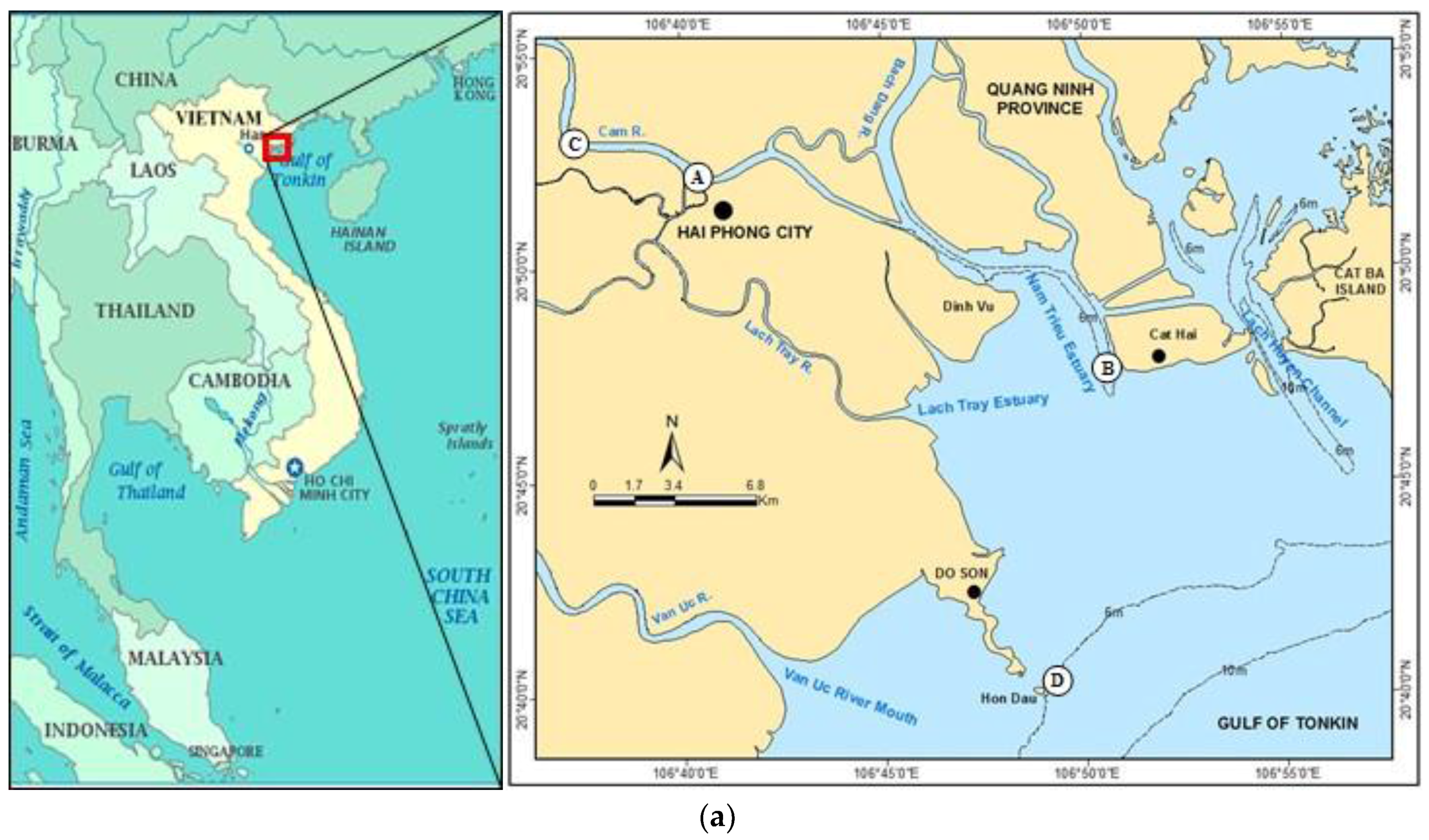
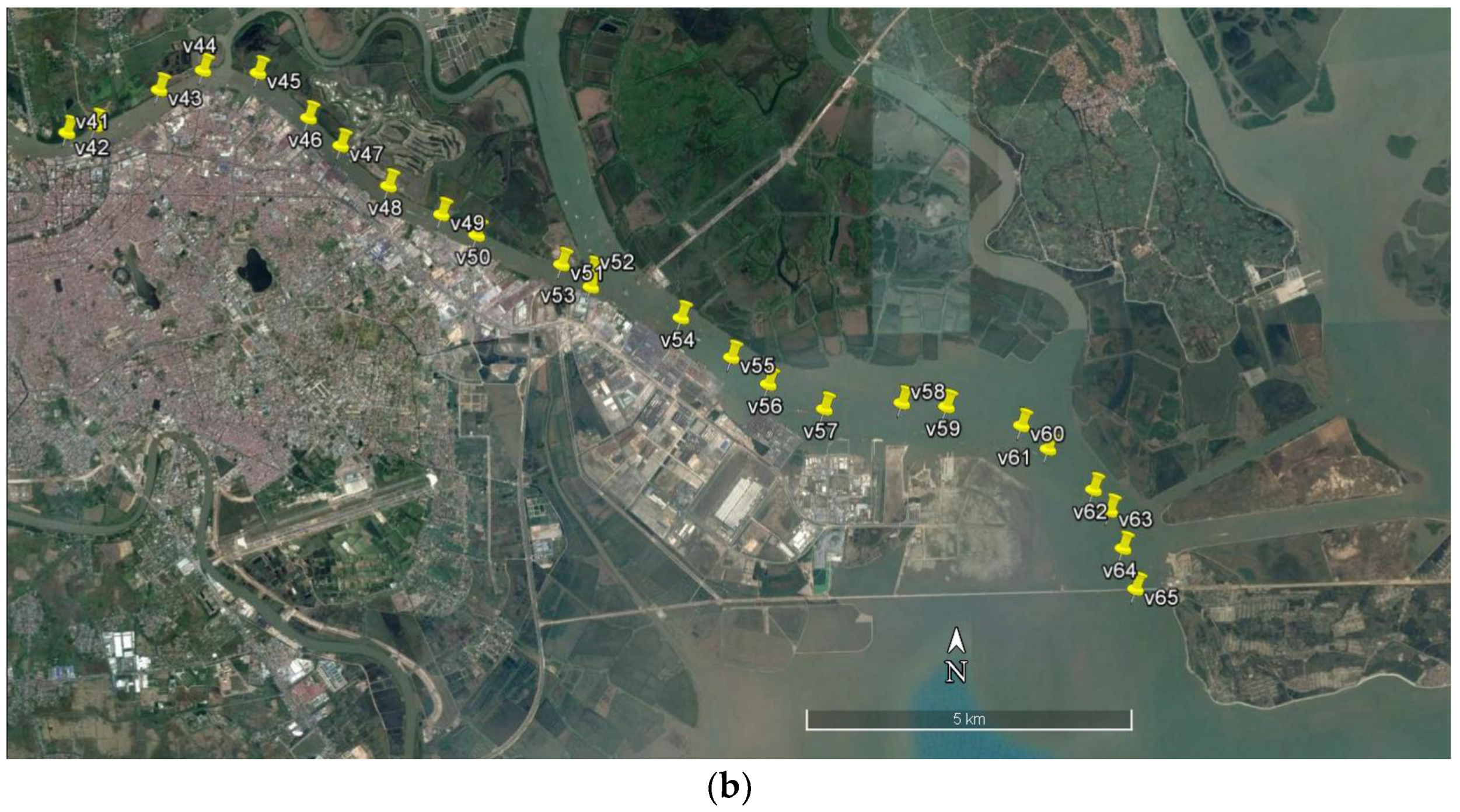
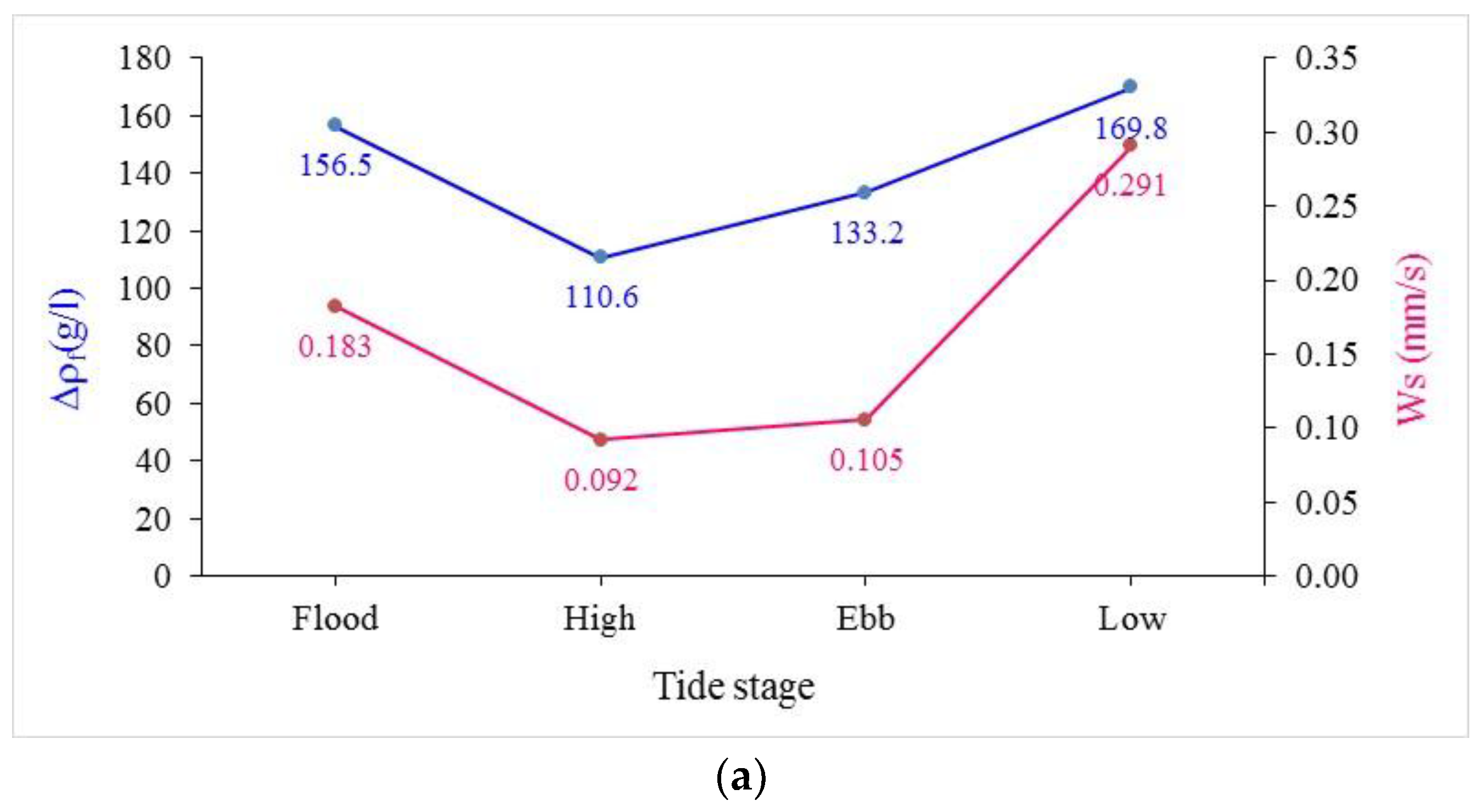
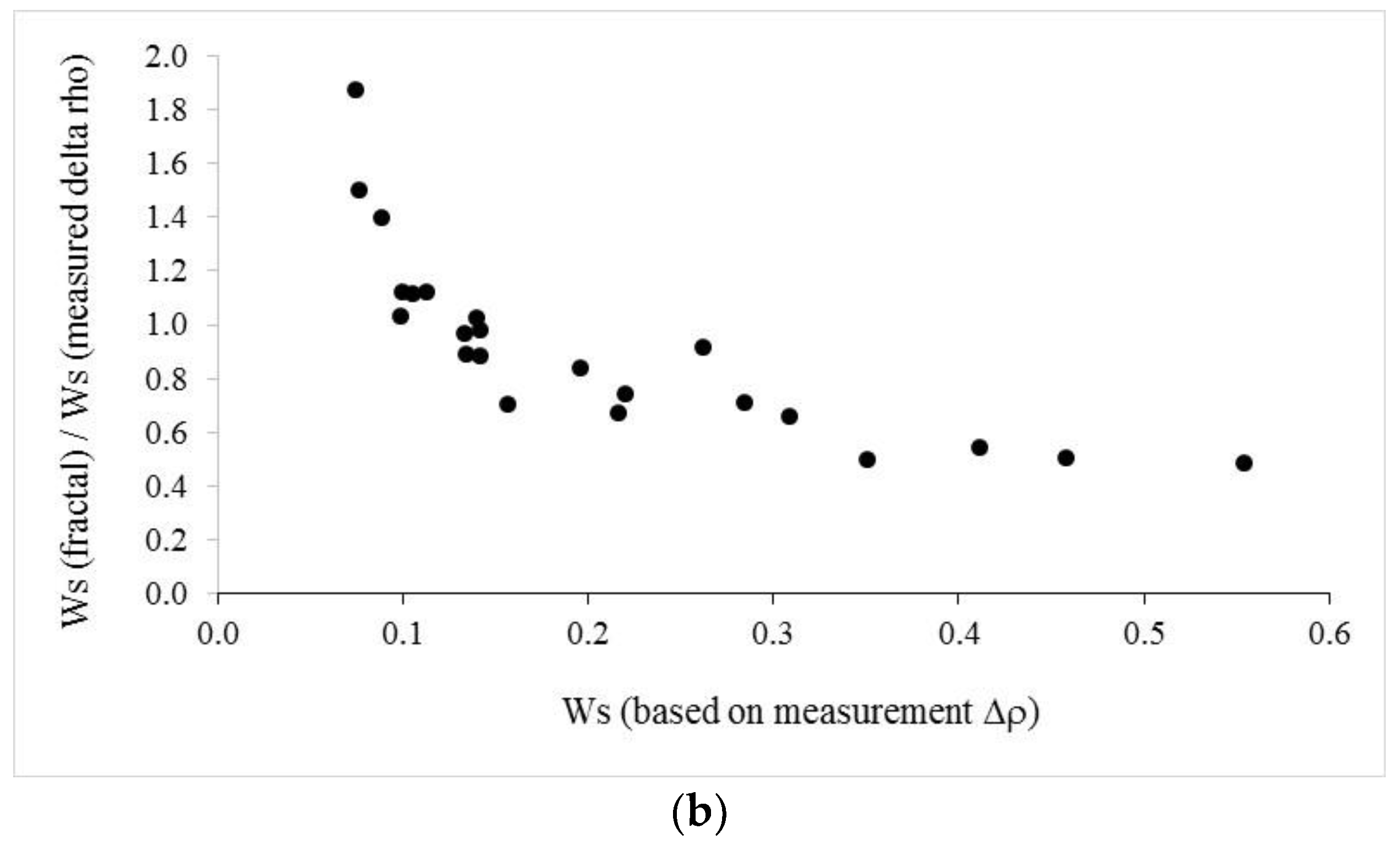
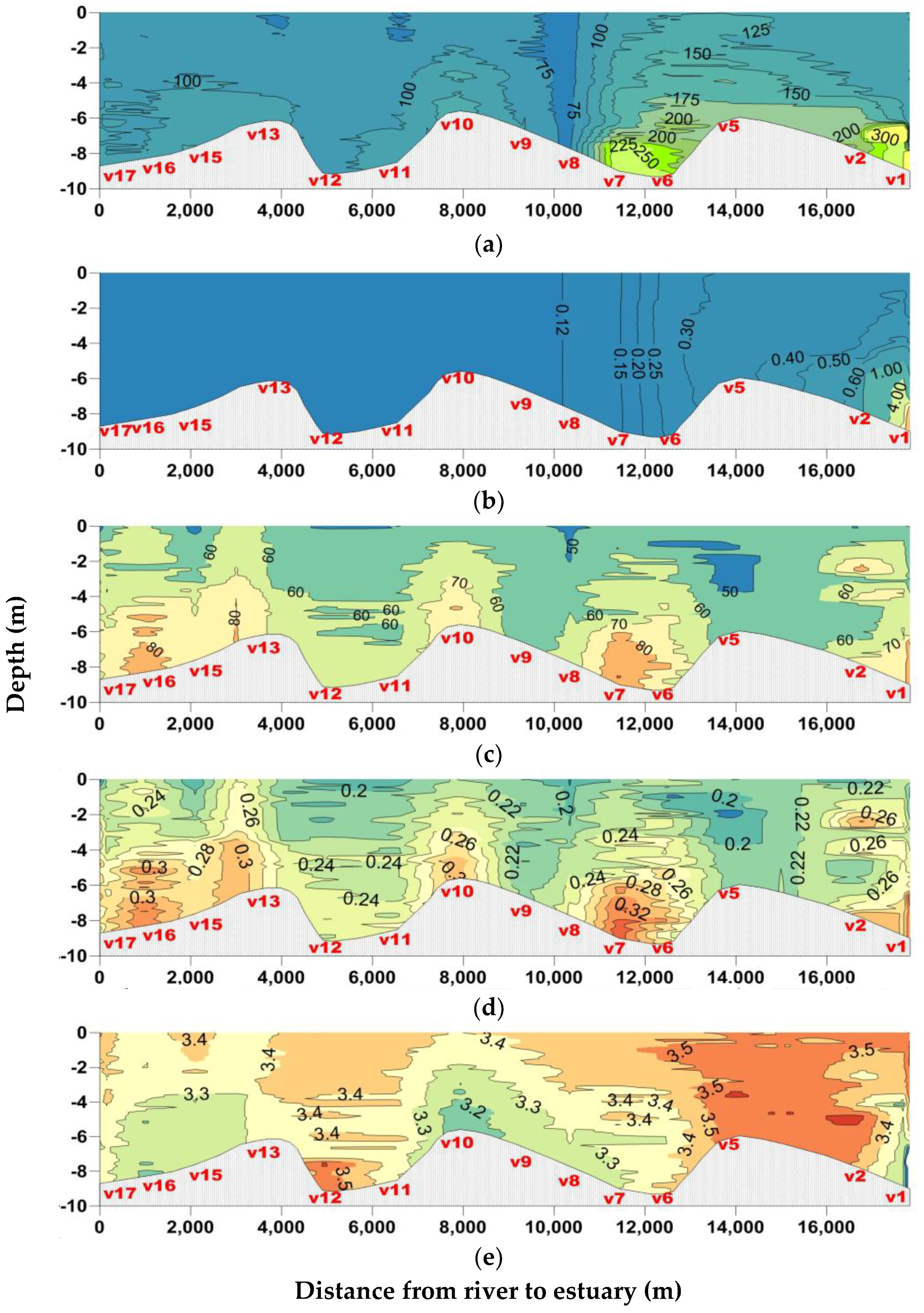
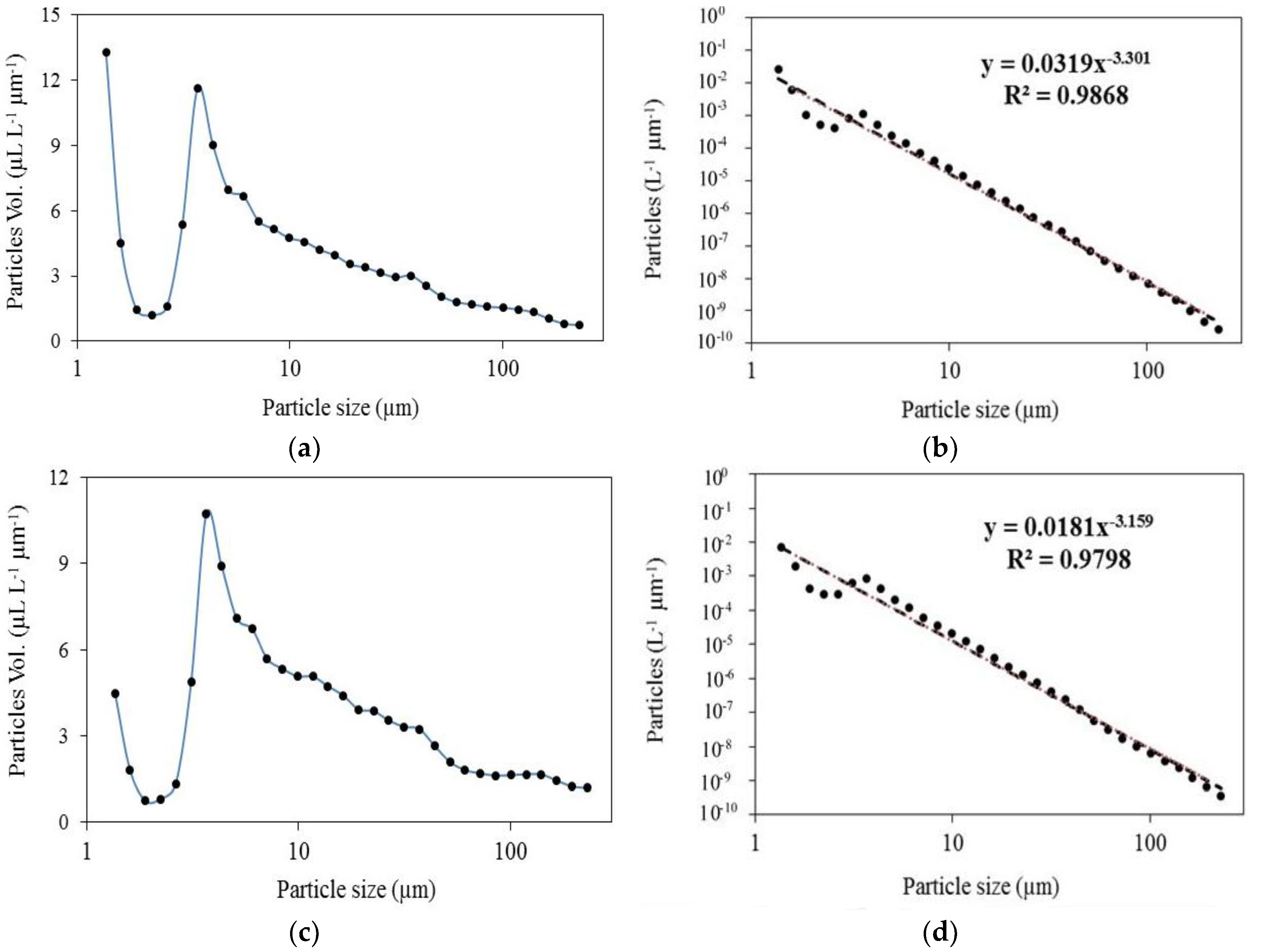
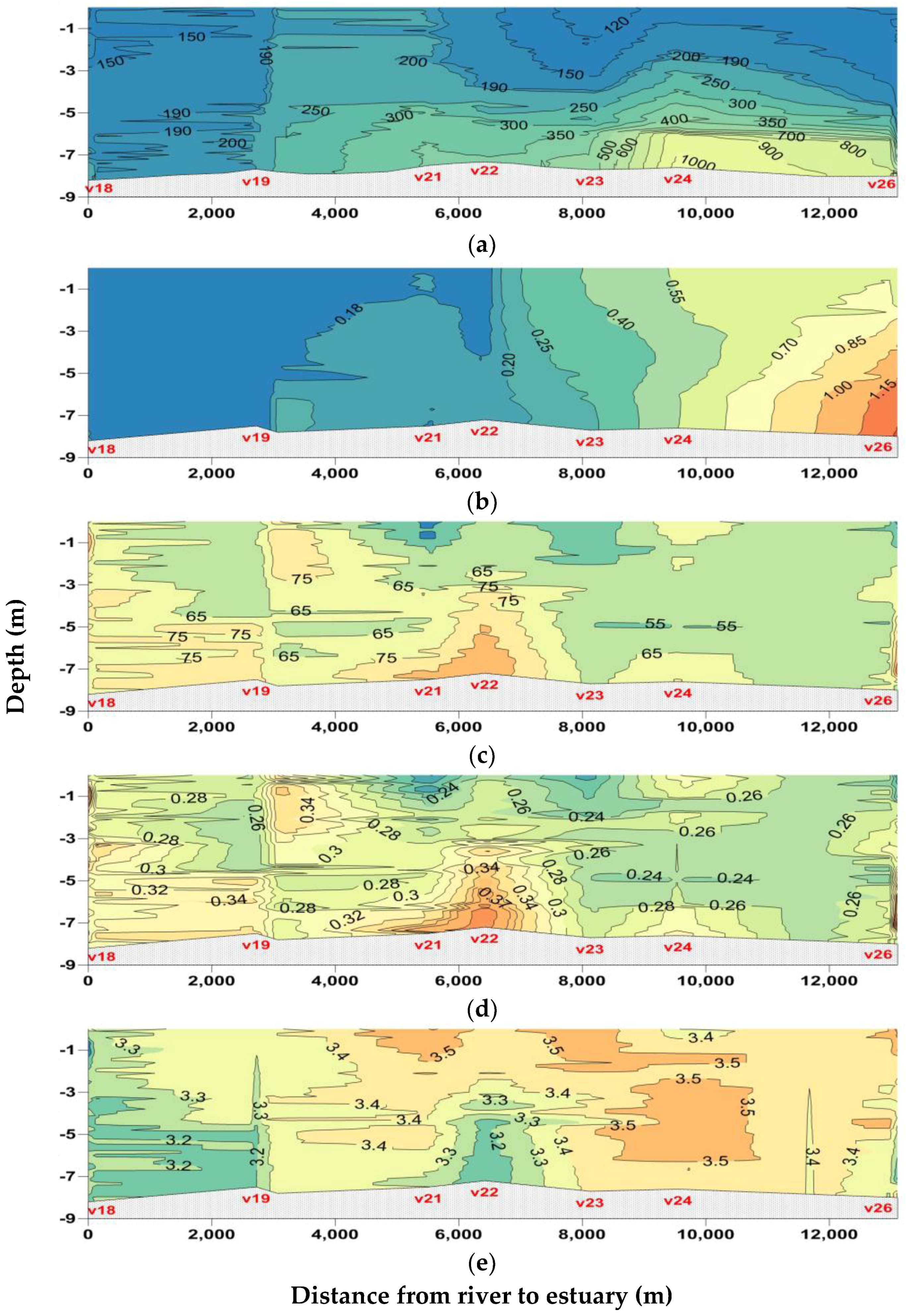

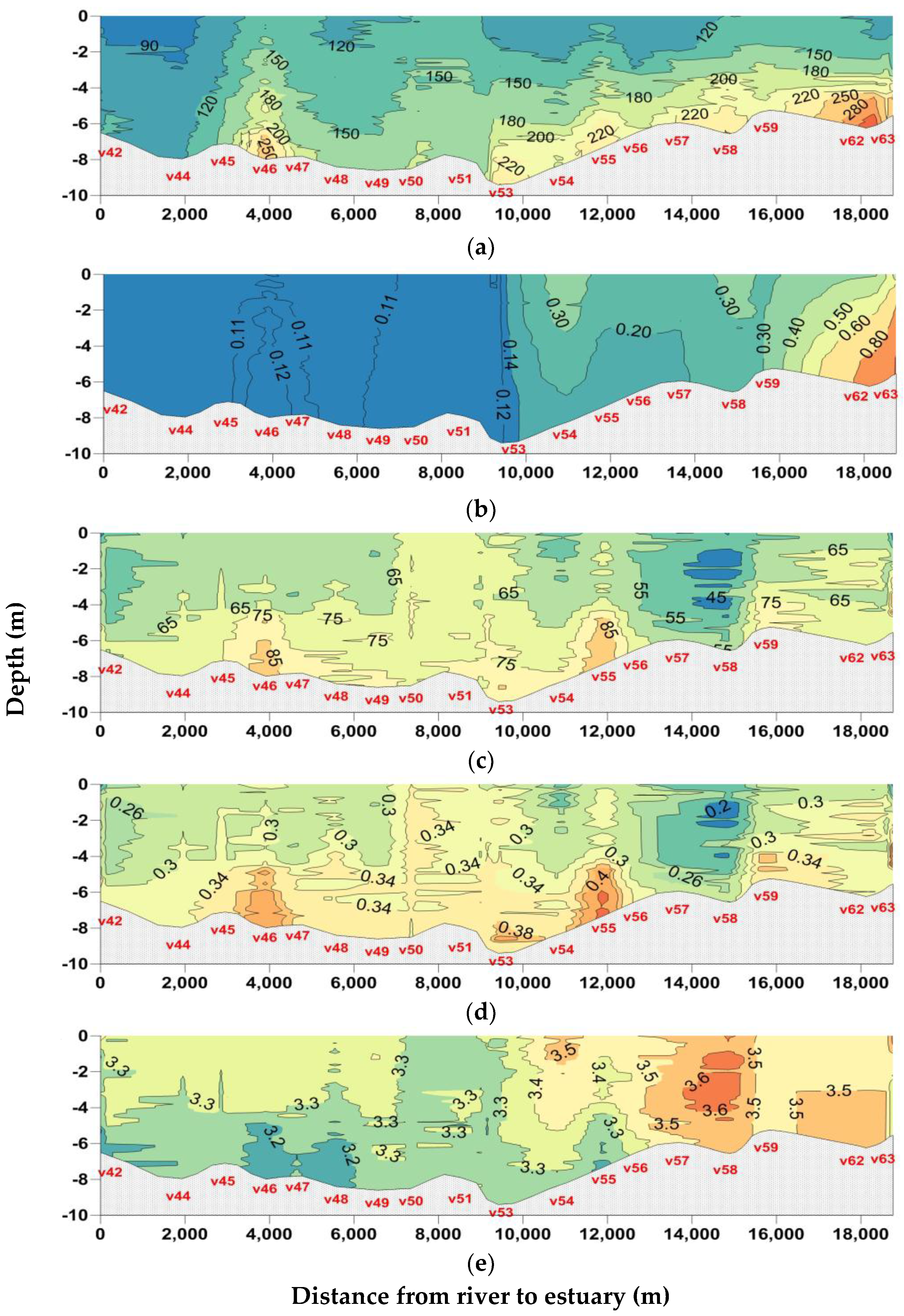
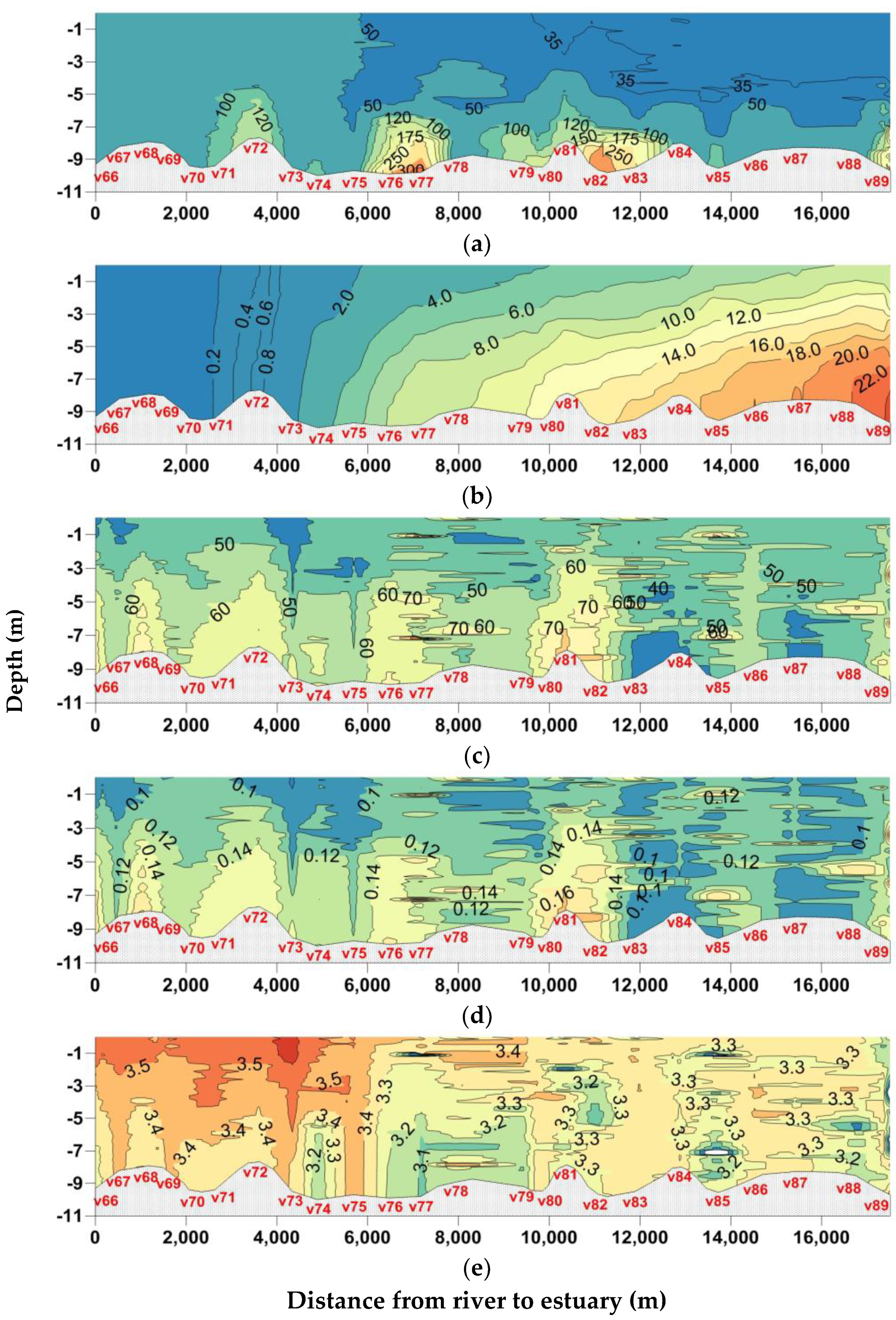


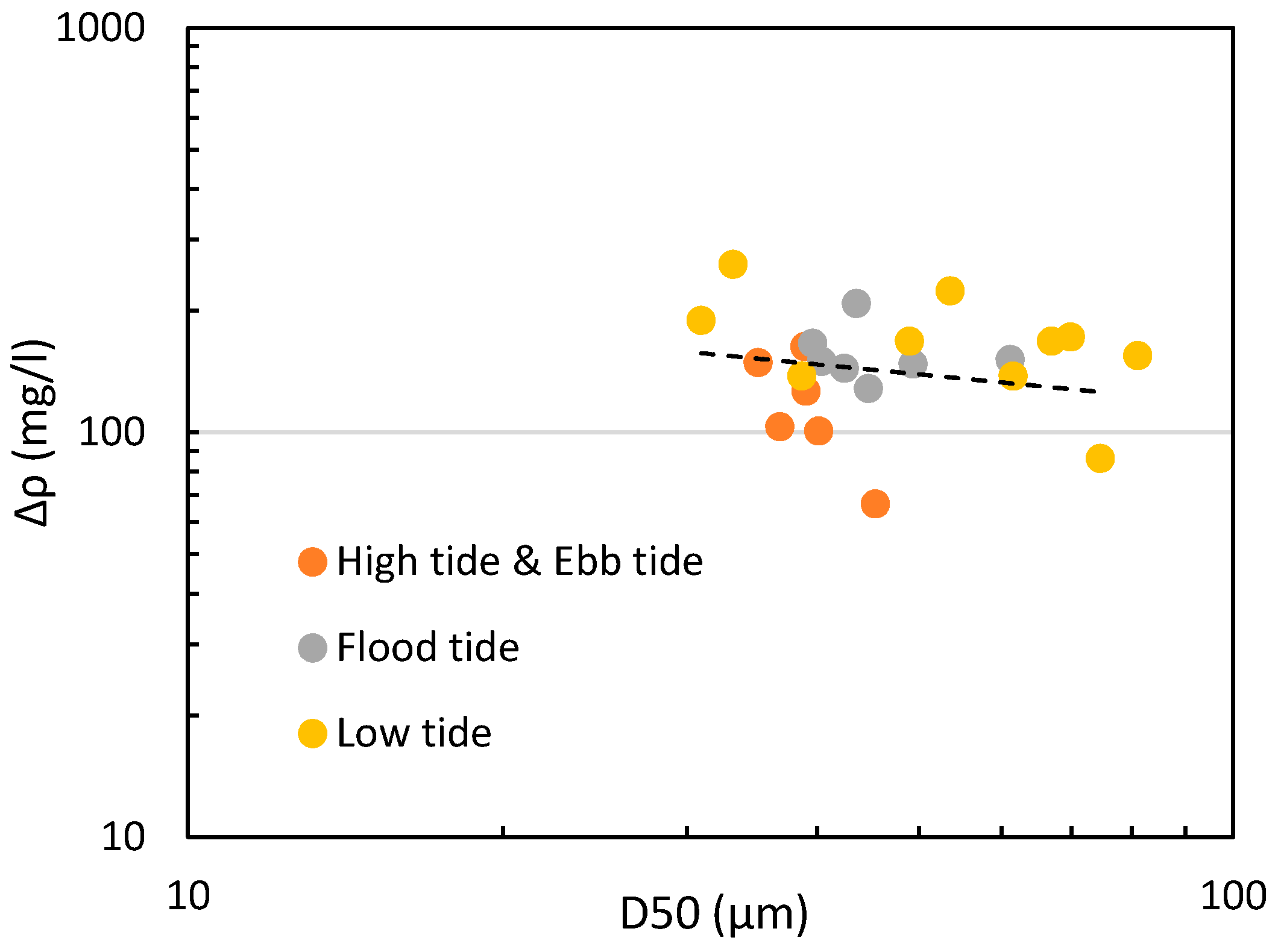

| Tidal Phase/Transect | Upstream in Cam River (Station C) | Mean Salinity (psu) | Grain Size Group | |||||||||||||||
|---|---|---|---|---|---|---|---|---|---|---|---|---|---|---|---|---|---|---|
| Fine Flocs (1.48–17.7 μm) | Medium Flocs (17.77–92.6 μm) | Coarse Flocs (92.6–212 μm) | Full Range (1.48–212 μm) | |||||||||||||||
| Q (m3 s−1) | SPM (mg L−1) | D50 (μm) | Volume (%) | ws (mm s−1) | J | D50 (μm) | Volume (%) | ws (mm s−1) | J | D50 (μm) | Volume (%) | ws (mm s−1) | J | D50 (μm) | ws (mm s−1) | J | ||
| Flood tide/transect 1 | −235.2 | 56.3 | 0.18 | 8.30 | 22.28 | 0.031 | 3.23 | 44.77 | 35.16 | 0.174 | 3.48 | 131.84 | 41.56 | 0.522 | 3.84 | 64.48 | 0.253 | 3.37 |
| Low tide/transect 2 | 1252.5 | * | 0.30 | 8.37 | 18.91 | 0.035 | 3.23 | 47.88 | 37.53 | 0.206 | 3.35 | 130.96 | 43.56 | 0.580 | 3.96 | 72.24 | 0.316 | 3.36 |
| Flood tide/transect 3 | 137.0 | 113.0 | 0.92 | 7.94 | 28.30 | 0.026 | 3.40 | 42.93 | 35.99 | 0.143 | 3.7 | 129.99 | 35.71 | 0.436 | 4.04 | 51.43 | 0.172 | 3.55 |
| Low tide/transect 4 | 1210.0 | * | 0.22 | 8.39 | 20.22 | 0.037 | 3.20 | 47.00 | 37.63 | 0.221 | 3.42 | 131.67 | 42.16 | 0.642 | 4.00 | 69.37 | 0.333 | 3.37 |
| High tide/transect 5 | −463.8 | * | 6.76 | 8.25 | 27.86 | 0.020 | 3.11 | 41.03 | 35.72 | 0.094 | 3.82 | 134.29 | 36.43 | 0.296 | 3.59 | 51.07 | 0.116 | 3.37 |
| Ebb tide/transect 6 | 1096.0 | 107.0 | 4.15 | 8.58 | 25.79 | 0.024 | 3.08 | 42.37 | 38.77 | 0.113 | 3.73 | 131.38 | 35.44 | 0.345 | 3.87 | 52.83 | 0.141 | 3.38 |
| Transect | Upper ETM | Lower ETM | ||||||||||||||||||||||
|---|---|---|---|---|---|---|---|---|---|---|---|---|---|---|---|---|---|---|---|---|---|---|---|---|
| L (km) | Turb. (NTU) | S (psu) | Station | Ri | Φ | D50 (µm) | ws | J | L (km) | Turb. (NTU) | S (psu) | Station | Ri | Φ | D50 (µm) | ws | J | |||||||
| Full | Fine | Medium | Coarse | Full | Fine | Medium | Coarse | |||||||||||||||||
| 1 Flood tide | 3 | 100–250 | 0.13–0.35 | v6 | 0.13 | 0.98 | 71.73 | 8.29 | 46.52 | 132.73 | 0.28 | 3.34 | (1) | 125–300 | 1–4 | v1 | - | 57.12 | 62.86 | 8.13 | 44.99 | 131.27 | 0.26 | 3.51 |
| 2 Low tide | 4 | 200–300 | 0.15–0.25 | v21 | 0.05 | 0.97 | 65.50 | 8.51 | 46.42 | 130.95 | 0.28 | 3.44 | (5) | 700–1000 | 0.4–1.2 | v24 | 0.11 | 1.22 | 56.8 | 7.82 | 47.75 | 136.10 | 0.25 | 3.50 |
| 3 Flood tide | 4 | 120–450 | 0.1–0.15 | v37 | 0.05 | 1.86 | 45.82 | 7.99 | 43.12 | 127.82 | 0.15 | 3.60 | 6 | 150–900 | 0.3–10 | v30 | 0.28 | 86.99 | 50.87 | 8.37 | 42.10 | 130.33 | 0.17 | 3.55 |
| 4 Low tide | 4 | 120–250 | 0.1–0.12 | v46 | 0.06 | 0.74 | 78.58 | 8.55 | 48.81 | 133.10 | 0.38 | 3.27 | 9 | 150–280 | 0.14–1.0 | v62 | 0.19 | 3.06 | 64.20 | 7.95 | 46.93 | 133.53 | 0.31 | 3.55 |
| 5 High tide | 1 | 100–120 | 0.2–0.8 | v72 | 0.20 | 2.05 | 54.20 | 7.70 | 42.97 | 133.74 | 0.12 | 3.55 | 1–1.5 | 100–250 | 6–12 | v82 | 1.53 | 80.93 | 62.07 | 8.46 | 41.53 | 136.81 | 0.14 | 3.25 |
| 6 Ebb tide | 4 | 120–200 | 0.15–0.8 | v104 | 0.23 | 1.63 | 57.10 | 8.50 | 44.57 | 131.52 | 0.16 | 3.40 | 2 | 100–200 | 4–10 | v95 | 1.16 | 66.64 | 55.65 | 8.76 | 41.45 | 135.38 | 0.15 | 3.36 |
© 2018 by the authors. Licensee MDPI, Basel, Switzerland. This article is an open access article distributed under the terms and conditions of the Creative Commons Attribution (CC BY) license (http://creativecommons.org/licenses/by/4.0/).
Share and Cite
Duy Vinh, V.; Ouillon, S.; Van Uu, D. Estuarine Turbidity Maxima and Variations of Aggregate Parameters in the Cam-Nam Trieu Estuary, North Vietnam, in Early Wet Season. Water 2018, 10, 68. https://doi.org/10.3390/w10010068
Duy Vinh V, Ouillon S, Van Uu D. Estuarine Turbidity Maxima and Variations of Aggregate Parameters in the Cam-Nam Trieu Estuary, North Vietnam, in Early Wet Season. Water. 2018; 10(1):68. https://doi.org/10.3390/w10010068
Chicago/Turabian StyleDuy Vinh, Vu, Sylvain Ouillon, and Dinh Van Uu. 2018. "Estuarine Turbidity Maxima and Variations of Aggregate Parameters in the Cam-Nam Trieu Estuary, North Vietnam, in Early Wet Season" Water 10, no. 1: 68. https://doi.org/10.3390/w10010068






